How & When to Swap Bread Flour for All-Purpose in Mini-Wreath Pain d’Epis
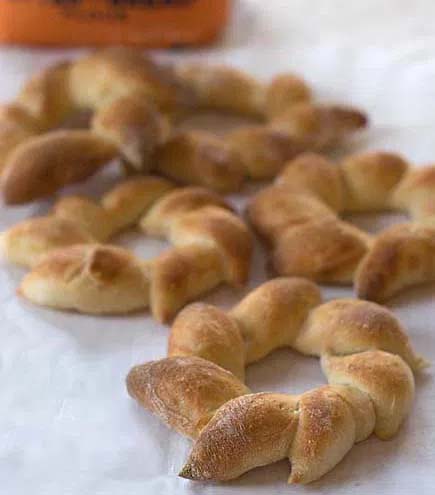
People often ask us why we only used all-purpose flour (where we called for white flour) in The New Artisan Bread in Five Minutes a Day. Why not “bread” flour, which is higher in protein and is often considered traditional in bread? Well, not in all traditions. French baguettes, for example, are typically made with lower-protein flour for a more tender, and less chewy crumb. And we knew most of our potential book users already had all-purpose flour in the house. But sometimes, a stiffer dough is desirable, like when something really needs to hold its shape, like these wreath-shaped, well… bagels. You can always swap bread flour into our recipes that call for all-purpose, just by adding a little extra water (details below).
Today’s treats weren’t really bagels, since I didn’t boil them before baking, but they did start life shaped just like our regular bagels. Then, they get the snipping treatment like our Pain d’Epi (wheat-stalk bread, a French trick of the eye)…
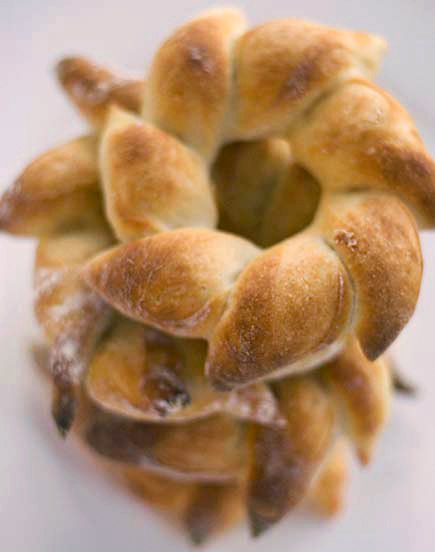
We’ve been doing a round version of the Pain d’Epi for years–take a ring-shaped bread and cut it like an Epi–kind of like a wreath. Seems you ought to be able to make little ones: (wreath-bagels). I thought this would be easier to accomplish with higher-protein flour (for a stiffer dough), so I tested with bread flour. And they certainly held a beautiful shape–just look at the pictures.
I used our basic white-flour recipe, but since I was swapping in bread flour, which is higher in protein and absorbs more water, I increased the water by 1/3 cup (see our FAQ for details on adjusting for other flours). This will work for any of our recipes that call for all-purpose flour–you need a little less than 1 tablespoon extra water for each cup of bread flour that you swap for all-purpose. Today, I weighed the flour and water on a digital scale— the normal recipe (with all-purpose flour) calls for 2 pounds of flour and 1.5 pounds water, but since I was using bread flour, I used more water; that extra 1/3 cup works out to a total of 1 pound, 10 3/4 ounces of water…

(… for more about using digital scales click here.) I used a Danish dough whisk to mix the water, salt, yeast, and flour, but a wooden spoon would have been fine too. You can see that it’s wet, but not as wet and shapeless as our all-purpose flour basic white dough when first mixed:
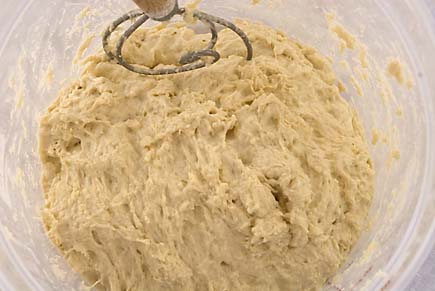
After about two hours of rising at room temperature (assuming you started with lukewarm water), it can go into the fridge, where it can be stored for up to two weeks, though I used my stuff right after the 2-hour rise.
Preheat the oven to 450 degrees F, with a baking stone near the center of the oven and an empty metal broiler tray on any other shelf that won’t interfere with the bagels. In most ovens, 20 or 30 minutes will be enough, in others you may need up to 45 minutes (check temp with an oven thermometer). Dust the surface of the dough with flour and snip off 3-ounce portions of dough (the size of small peaches). Despite the fact that the dough isn’t kneaded, wet dough like this one sets up structure and stretch on its own:
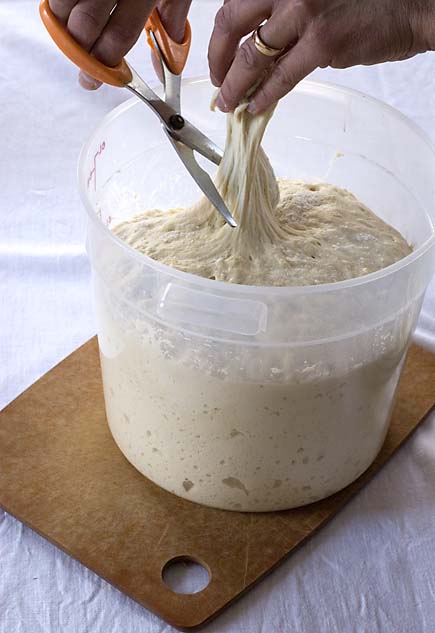
Dust with flour and shape the piece of dough into a smooth ball as we described in the Basics post, and then poke your thumbs through:
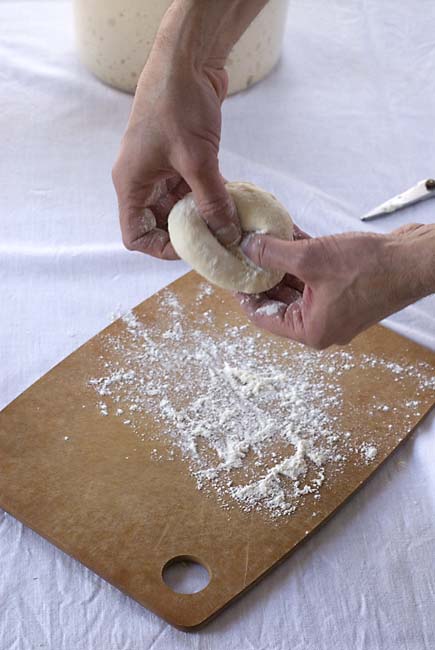
… and start stretching…

Keep stretching, dusting with flour as needed, until the hole is about three times the width of the sides, otherwise the bagel-hole will close up:

Lay them on parchment paper or a silicone mat rated to the baking temperature. They’ll partially shrink back when you put them down.
Cover loosely with plastic wrap if you’re in a dry environment, and allow to rest for 20 minutes. You won’t see much rising during that time.

Dust with flour and use a kitchen shears to snip down nearly all the way through, cutting at a shallow angle (about 30 degrees). Deflect the cut pieces sideways, away from the center of the bagel:
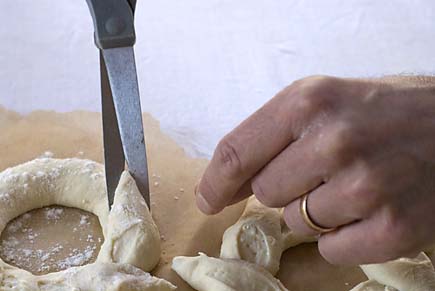
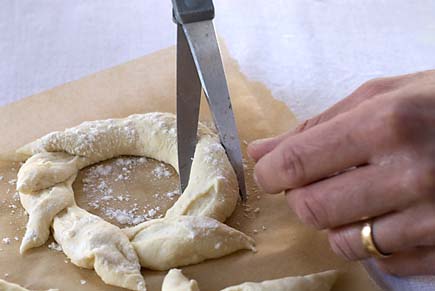
Get under the parchment with a pizza peel…

… and slide the whole thing, paper and all, onto the hot stone. Carefully pour 1 cup of water into the metal broiler tray (cover the glass oven window with a towel before approaching with water to prevent cracking of the glass), or check out our post on steam alternatives for other ways to generate steam in the oven. Slide into the oven and bake with steam for about 15 to 20 minutes at 450F, or until richly browned.
You can enjoy these slightly warm…
Hooray and thank you! Look forward to the books.
Hi Erin,
Use them with your family in good health! Happy Holidays!
Cheers, Zoë
thanks for that short explination of the difference in the flours. I wish there were some place detailing all the types of flours and there differences.
I plan to use this cutting method on some larger loafs for Christmas gifts.
Steve
Hi Steve,
That is a great idea for a post, I will get to work on an explanation of all the types of flours. This is just the kind of geeky baking post I love!
Cheers, Zoë
Could you acheive a bread flour like effect by adding a little gluten to all purpose flour?
Hi Josh,
The only real difference between all-purpose flour and bread flour is the protein content. By adding a small amount of vital wheat gluten (protein) to all-purpose you will get the same effect as bread flour. The amount of VWG to add is determined by the protein content of the all-purpose flour you are starting with.
Thanks, Zoë
how do you know how much vita wheat gluten to add? Is it trial and errror? I put about 1 T. to the 6 1/2 cups of flour when I want a stiffer dough. seems to work…I also always use unbleached flour.
Hi Mary lou,
It depends on the result you are trying to achieve. If you are happy with the results adding 1 tablespoon, then that is great. You could probably increase it to 2 Tablespoons as well. Try it next time and see which you prefer.
Thanks, Zoë
1.5 pounds water plus 1/3 cup=1lb 10.75 ounces, no? Did I miss something? These look delightful.
Thank you Bridgit,
We fixed the error in the post!
Cheers, Zoë
I love the addition of scale measuring – using a scale myself has provided more consistent results for me, particularly as living in Montana, I use Wheat Montana (brand)flours.
I have my 2nd try at the “Pain d’Epi” technique…a Christmas Bagel :)! – looks better this morning than the one I tried last night.
Thanks for inspiration and I look forward to the flour post.
Which dough did you use for the photo shoot? (I get the part about the flour)
Hi Helen,
Jeff used the master recipe from ABin5!
Thanks, Zoë
Can the healthy artisan breads be par baked? I couldn’t find this info in the book. I par baked the artisan breads and found it a great timesaver.
Hi Pam,
Yes, the whole grain breads can be par-baked in just the same way you would with the artisan breads.
Thanks! Zoë
Thank you so much for your quick reply. We just love all the breads at our house and I love how easy they are to make.
Hi,
I am from Australia and would like to say thankyou for some great bread!
I was just wondering what happens if you add flour and knead the bread a bit longer than I should??
I have made a batch today and looks great.
Thankyou
Angela
Hi Angela,
You can knead the dough when you first mix it up with no ill effect, it just doesn’t make much of a difference and adds work.
Enjoy all the bread! Zoë
Thankyou Zoe
Sorry Zoe,
Just a quick question.
When you get it ready for the oven, mould it, does it matter if you knead it as well with extra flour?
Thanks
Hi Angela,
If you knead the dough when you are shaping the loaf it will end up being denser. If you do knead, you need to let the loaf rest longer, like an hour or more. If you add extra flour, it will also require more resting time.
Thanks, Zoë
Thanks Zoe, for your quick response.
Great answer!
Who won the books?
Hi Ellen,
The winner is announced at the very bottom of this post.
Thanks and Happy New Year! Zoë
I have a friend who needs to be on a completely sodium free diet for a while. Will the breads work as well without salt?
Nina: They will, but taste and texture will suffer. Doesn’t work well at high altitude though.
This is probably an Artisan stretch but what about combining a wreath with a wheat stalk to form a sunflower? Is it possible or even advisable?
John: Sure, can’t see why not.
Could the extra protein in the bread flour make up for using the VWG in the HBin5 recipes where some AP flour is used along with the whole grains?
Robin– yes, to some extent, though you may find it a little dense. matter of taste!
Jeff, I am enjoying making recipes from your first book. Question re the wetness of the pumpernickel dough, especially to make it with walnuts and raisins.
After several attempts, including adjusting flour for homemade caramel coloring … I continue to find that the dough is wet. Yes, even wet sticky dough will rise and bake into something, but is otherwise impossible to flatten and roll to add nuts and fruit etc.
Is it just a matter of keep adding flour until the dough pulls away from the bowl completely? Recommendations? Thanks.
Steve: Depends on how much liquid you’re talking about with the homemade caramel color. You need about twice the volume of flour as you had extra liquid. But yes, you go by how the dough looks, just as you mention.
Gave a loaf of the peasant bread to my neighbor (along with homemade soup) for plowing the driveway. his wife asked if I could add sunflower seeds or other seed to make it even better. (she gets aloaf like that at the bakery….any thoughts???? thanks
Yep, I do that all the time, they’re great. 1/4 cup or more per batch, max about a 1/2-cup. See the sunflower seed bread in ABin5 https://bit.ly/cNtfJI
Hi – I’m in a bind and looking for a suggestion that doesn’t include driving to the grocery store.
I was about to mix up another batch of artisan bread (basic boule recipe) and discovered I’m out of all purpose white flour. I have only 1.5 – 2 cups of Gold Medal bread flour. My other flours are the same amount of Red Mill whole wheat and 2 – 3 cups of stone ground WW flour from a local grower. I also have a box of Hodgson Vital WG.
I re-read page 8 of ABin5, but don’t know if I can adjust this recipe with the ingredients I have at hand. Any suggestions are appreciated!
Confused! Which recipe are you trying to swap into? If you’re just using bread flr in place of AP in an all-white recipe, see our FAQ (tab above) and click on Flour varieties: Do I need to adjust the liquids when I use different kinds of white flour?
Sorry for the confusion. I have done several searches on substitutions on your site and can’t find an answer to my question.
I want to make the basic boule (p.26 ABin5) but I only have 2cups of bread flour and a lot of Wheat flour. My question:
Is there a way to use mostly, or all, wheat flour in that recipe and still have it turn out okay?
I read the FAQs and saw a possible answer in HBin5, but I don’t have that book yet.
If I’m still not making sense, please accept my apologies and ignore the post. The simplest solution is to wait until I can buy more white flour!
Short answer, you can use up to about 1/3 of the flour as whole wheat w/o making major adjustments. Beyond that, it doesn’t store well w/o vital wheat gluten as we use in HBin5.
May need a little more water to account for the whole wheat, given how much U want to use.
Just wanted to let y’all know that I won a blue ribbon and best of show at the South Carolina State Fair for my croissant recipe that I developed from your books. I am old time bread maker and only make bread using your method now. Thank you for your books.
thanks for letting us know Sara!
Sara, that sounds wonderful! Would you be willing to share your personally developed croissant recipe? I have yet to find a great recipe for making croissants!
Thank you!
Jonni
Dear Jonni:
It might take me a bit to get it posted. But if you can be a little patient, I will be happy to share it.
Jonni, I would like to see that recipe too..
sounds great….
oops I mean, Sara, I would like to see your recipe….thanks
Here is the recipe. If you have a problem, just let me know. Good luck. Sara
Croissants
2 Cups unbleached all purpose flour
!/2 t salt—may be omitted if using salted butter
1/2t baking powder
1 Cup very cold butter—cut into pats
2t yeast
½ Cup sour cream
Whisk together the dry ingredients. Add the butter and work in until a course crumbly mixture. Leave most of the butter as large pea shaped pieces. Pieces can be fairly large.
Stir in the sour cream. Dough will not be cohesive. Turn out on a floured surface and bring together with a few quick kneads. Wet your hands if you are having trouble. Dough will be crumbly
Roll dough into an 8X10 rectangle on a floured surface. Fold in 3 like a business letter. Turn dough a quarter turn and repeat. Repeat one or two more times. The more turns the more layers. But don’t let butter start to melt.
Chill dough for at least 30 minutes. Overnight is even better. Dough may be kept in refrigerator or frozen at this point
To make croissants:
Roll dough into a rectangle on a floured surface….approximately 12X20-24 inches.
Cut in half and then into triangles—depending on the size croissants you can make 8-16 rolls.
Let dough rise 1-2 hours. Whatever you have time for.
Brush with egg and water mixture.
Make 350 degree oven 20 minutes or until golden
Hi Sara,
Looks like an interesting recipe!
Thanks, Zoë
I have also made the above recipe filled with Nutella, cinnamon and nuts and lots of other things. You can also sprinkle coarse sugar on top of the egg wash
Help! I got some Better for Bread flour this week intending to make bagels and pretzels (actually, I really want to make pretzel-rolls like we always got in Germany). I made the dough and left it on the counter for its two-hour rise… and forgot about it until the next morning. Have I ruined it? Should I go ahead with the bagels or make something else with the dough?
Hi Ulrike,
No, you haven’t ruined the dough, it can still be used and will be just fine. Dough that has dairy and eggs can not be left out, but bagel dough is fine.
Thanks, Zoë
Oh, good! I wasn’t worried about it being unsafe, just that it might not work well for the bagels.
Thanks!
Hi,
I have just been given a big bag of wholemeal (Americans would say ‘whole wheat’, I think) bread flour.
Do you think if I make the Healthy Bread in 5 recipes with this, it is likely ok to omit the vital wheat gluten? Or is it safer to retain the gluten?
PS love your books. I could never make yeast bread successfully before this!
Should be fine with wholemeal, I baked with it when I’ve traveled in the UK, assuming that’s where you’re located (yes, I bake my own bread on vacation/holiday). If you leave VWG out of the whole grain recipes, the dough won’t store as well, and the results will be denser– plus you’ll have to decrease the water or the dough will be too wet. You’d have to experiment, there’s no hard and fast rule as to how much decrease.
But it’s definitely possible to do it that way. I’ve heard this isn’t easy to find in the UK. Online?
What type of scissors are you using? My husband wants a pair like those we saw in San Francisco, but I haven’t located.
In this photoshoot, they’re cheap kitchen shears from Target bought years ago, and I can’t recommend them–they disassemble by themselves all the time! These days I use stainless steel office scissors from an office supply store, because they have longer blades, which makes this particular snipping job much easier. Are they food safe? I can’t say, but I do run them through the dishwasher.
What is vital wheat gluten and where can i find it?
Hi Roberta,
Here is a post that will explain all about VWG. https://artisanbreadinfive.com/2009/10/26/our-new-book-healthy-bread-in-five-minutes-a-day-is-released-tomorrow-get-yourself-some-vital-wheat-gluten-and-make-our-whole-grain-master-recipe
Thanks, Zoë
Jeff, thanks so much for this post! After starting the master recipe tonight, I discovered we only had bread flour on hand. It was so helpful to discover that more water would be needed — and how much more!
My family members all love the bread made using recipes in the New Artisan Bread in Five Minutes a Day. Kudos to you and Zoe!
Hi Kit, thanks for the lovely note, so glad you and your family are enjoying the bread!
Cheers, Zoë
Thanks so much for the explaintion. Now I know if I don’t
Have bread flour in house I can substitute all purpose flour.
Can you tell me which flours are used in your book? I do some gf bread baking, but try to keep it low-carb, with seed flours, nut flours. I found a rustic sweet potato bread with seeds, using buckwheat flour. I also use gf all-purpose, and a fine-ground almond flour. I am interested in your book, but need a bit more info on the flours.
Which book, we have four (see the book images above)? Completely depends on the book. Are you completely gf? If so, all the books have a little gf, but only Gluten-Free Artisan Bread in Five Minutes a Day (on Amazon at https://amzn.to/1msOBmY) has only gf. I wouldn’t call it low carb, btw. Our flours in that book depend on mixing your own blends (a white and a whole-grain), and we tested those with Bob’s Red Mill gluten-free flours.